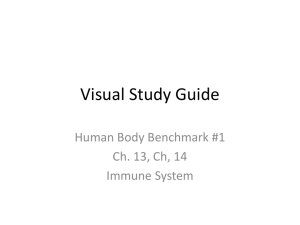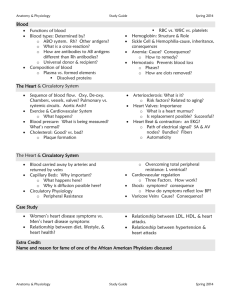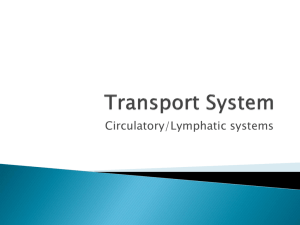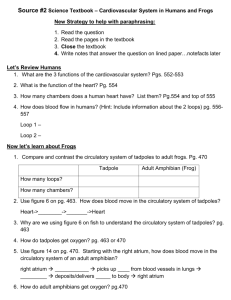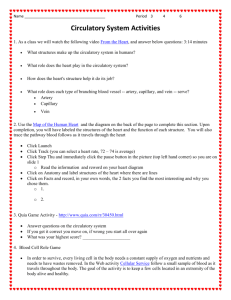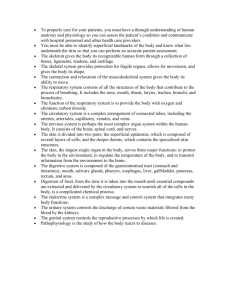2 THE CIRCULATORY SYSTEM
advertisement
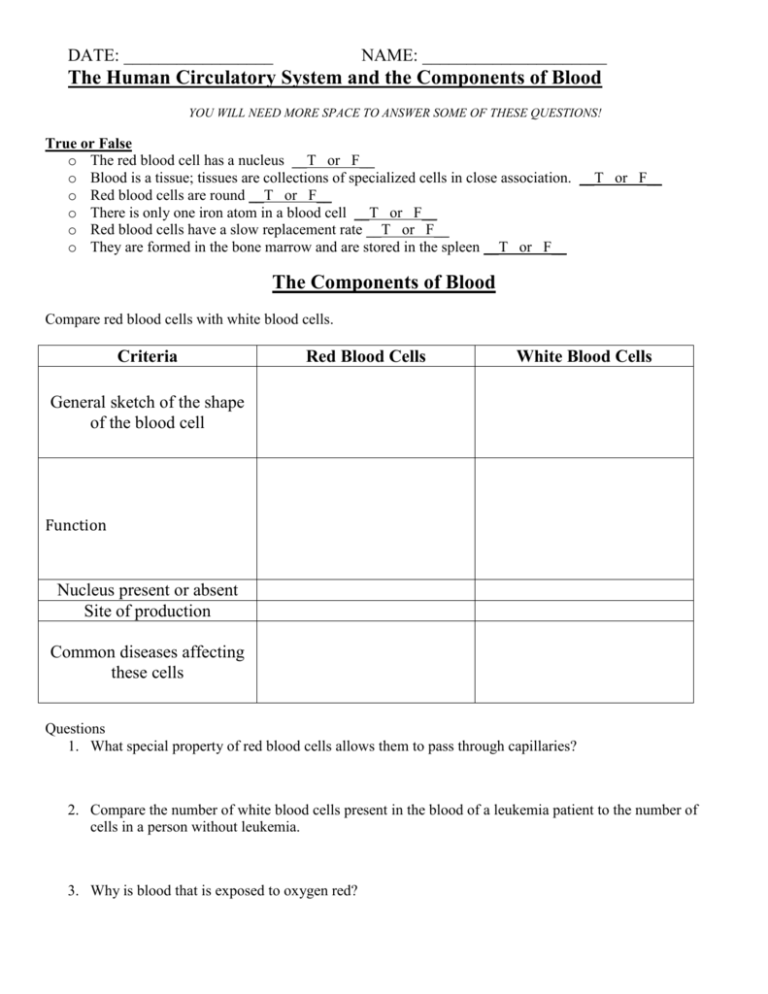
DATE: _________________ NAME: _____________________ The Human Circulatory System and the Components of Blood YOU WILL NEED MORE SPACE TO ANSWER SOME OF THESE QUESTIONS! True or False o The red blood cell has a nucleus __T or F__ o Blood is a tissue; tissues are collections of specialized cells in close association. __T or F__ o Red blood cells are round __T or F__ o There is only one iron atom in a blood cell __T or F__ o Red blood cells have a slow replacement rate __T or F__ o They are formed in the bone marrow and are stored in the spleen __T or F__ The Components of Blood Compare red blood cells with white blood cells. Criteria Red Blood Cells White Blood Cells General sketch of the shape of the blood cell Function Nucleus present or absent Site of production Common diseases affecting these cells Questions 1. What special property of red blood cells allows them to pass through capillaries? 2. Compare the number of white blood cells present in the blood of a leukemia patient to the number of cells in a person without leukemia. 3. Why is blood that is exposed to oxygen red? Circulatory System Concept Map Word List Blood clotting, atria, ventricles, blood, white blood cells, veins, blood vessels, platelets, one-way flow of blood, carry oxygen, pump The Structure and Function of the Human Heart and Blood Vessels True or False The human heart is a single pump __T or F__ Arteries have valves __T or F__ Although the circulatory system appears to be a tangled mess, blood flow is unidirectional __T or F__ The Circulatory System and the Heart 1. Label and colour in the parts of the circulatory system that carry oxygenated blood (in red) and deoxygenated blood (in blue) 2. Given the following diagram of the human heart, identify the indicated structures in the space provided. 3. Draw in arrows showing the direction of blood flow in the heart above. Use blue arrows for deoxygenated blood and red for oxygenated. The Sequence of Blood Flow Using the word list below, complete the following flowchart depicting blood flow through one complete loop of circulation, beginning and ending with the left ventricle. Word List Pulmonary artery, tricuspid valve, arteries, aorta, aortic semilunar valve, veins, bicuspid (mitral) valve, right atrium, capillaries, right ventricle, pulmonary vein, pulmonary semilunar valve, lungs, vena cava, left atrium Correct order: left atrium, The Circulatory System in Health and Disease True or False Heart disease is associated with being over the age of 50. __T or F__ A “sign” is something that is visible, while a “symptom” is something that must be described by the person who is ill. __T or F__ The heart muscle is irreplaceable once it is diseased and damaged. __T or F__ Smoking is one of the leading causes of heart disease. __T or F__ Heart Disease 1. Brainstorm some of the common causes of heart disease. Put a star next to the items on your list that you can control. (e.g.; Age, lack of exercise*, smoking*, high blood pressure*, genetics, diabetes*, high cholesterol*, family history of heart disease.) 2. Complete the following chart using the items from the above brainstorm. Causes That Are Preventable Causes That Are Not Preventable 3. Suggest some lifestyle changes that might help to promote health and reduce one’s risk of heart disease. 4. What responses in a normal individual are mimicked through the use of nitroglycerine by an angina patient? 5. What effect does nicotine have on the heart? Circulatory Systems in Various Organisms True or False all creatures have a four chambered heart. __T or F__ earth worms have real hearts __T or F__ 1. Distinguish between open circulatory systems and closed circulatory systems. 2. Describe how blood circulates in an earthworm. 3. What are some unique features of the circulatory system in a fish? 4. Describe the 3-chambered heart found in an amphibian. Practice Practice labelling this heart diagram without using your notes. Once you have given it a good try, use your notes to fill in and correct the mistakes. Your heart is worth learning about! 1. What is the the normal resting pulse rate for someone in your age range? 2. What is the normal range for an athlete in your age range? 3. One in three Americans are clinically obese and one four Canadians are clinically obese. Can you find a reason for this difference? 4. What is Canada’s recommendation for the amounts of exercise teenagers should get? 5. What is your target heart rate during exercise? 6. What is the maximum heart rate you should reach while exercising before encountering risks to your health? 7. Can you spell the name of the tool shown on the right? 8. Can you spell the name of the tool shown on the right? VERSION A - CARDIOVASCULAR HOMEOSTASIS QUESTIONS! Name: ___________________ YOU WILL NEED MORE SPACE THAN WHAT IS PROVIDED HERE TO ANSWER THESE QUESTIONS! The diagram shows the relative changes in the cardiovascular system during STRENUOUS exercise. 1. Which organs have increased blood flow during strenuous exercise? 2. Which organ has the greatest increase? 3. What is the significance of the increased blood the skin? flow to 4. What factors might affect this change in blood flow? 5. Which organs have decreased blood flow during strenuous exercise? 6. Which organ shows the biggest decrease? 7. In what ways can the cardiovascular system increase total blood flow (mL/min)? 8. You have a definite blood volume of 5000mL. How does the cardiovascular system increase blood flow to one organ, while at the same time decrease it to another organ? VERSION B - CARDIOVASCULAR HOMEOSTASIS QUESTIONS! YOU WILL NEED MORE SPACE THAN WHAT IS PROVIDED HERE TO ANSWER THESE QUESTIONS! The diagram shows the relative changes in the cardiovascular system during mild exercise. 1. Summarize the changes that occur mild exercise. with 2. What is the relationship between flow, exercise and cellular respiration? blood 3. Explain, in terms of cellular respiration, why each of the changes is advantageous. shown 4. Is this an example of homeostasis? Explain. VERSION C - CARDIOVASCULAR HOMEOSTASIS QUESTIONS! The graph shows the effect of different levels of exercise on several cardiovascular variables. 1. List, using numbers and units, changes that occur as the work exercise increases from 0 to 600 m/min. 2. the of kg- What is the relationship between cardiac output and cellular respiration, and between oxygen consumption and cellular respiration? Be as specific as possible. 3. Explain the significance of the changes in total peripheral resistance as exercise intensity increases. 4. What is meant by arteriovenous oygen difference? Explain what might account for the changes in arteriovenous oxygen difference exercise intensity increases. 5. Is this an example of homeostasis? Explain. as NAME: ___________________ DATE: ________________________ SYSTEMS PATHWAYS WORKSHEET Use the cut outs provided to place the words in order in the space below. OXYGEN PATHWAY ALVEOLUS CARBON DIOXIDE PATHWAY MITOCHONDRIA MITOCHONDRIA ALVEOLUS INGESTION PATHWAY FOOD IN MOUTH NUTRIENT PATHWAY STARCH MOLECULE RECTUM MITOCHONDRIA Identify by letter the location(s) of the organ(s), which is/are responsible for creating the enzymes, which digest the following macromolecules. There may be more than one letter responsible. Carbohydrate _______________ Protein ________________ Triglyceride ________________
